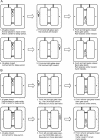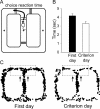Prefrontal cortex and hippocampus subserve different components of working memory in rats
- PMID: 18285468
- PMCID: PMC2275661
- DOI: 10.1101/lm.850808
Prefrontal cortex and hippocampus subserve different components of working memory in rats
Abstract
Both the medial prefrontal cortex (mPFC) and hippocampus are implicated in working memory tasks in rodents. Specifically, it has been hypothesized that the mPFC is primarily engaged in the temporary storage and processing of information lasting from a subsecond to several seconds, while the hippocampal function becomes more critical as the working memory demand extends into longer temporal scales. Although these structures may be engaged in a temporally separable manner, the extent of their contributions in the "informational content" of working memory remains unclear. To investigate this issue, the mPFC and dorsal hippocampus (dHPC) were temporarily inactivated via targeted infusions of the GABA(A) receptor agonist muscimol in rats prior to their performance on a delayed alternation task (DAT), employing an automated figure-eight maze that required the animals to make alternating arm choice responses after 3-, 30-, and 60-sec delays for water reward. We report that inactivation of either the mPFC or dHPC significantly reduced DAT at all delay intervals tested. However, there were key qualitative differences in the behavioral effects. Specifically, mPFC inactivation selectively impaired working memory (i.e., arm choice accuracy) without altering reference memory (i.e., the maze task rule) and arm choice response latencies. In contrast, dHPC inactivation increased both reference memory errors and arm choice response latencies. Moreover, dHPC, but not mPFC, inactivation increased the incidence of successive working memory errors. These results suggest that while both the mPFC and hippocampus are necessarily involved in DAT, they seem to process different informational components associated with the memory task.
Figures









References
-
- Amaral D.G., Witter M.P. Hippocampal formation. In: Paxinos G., editor. The rat nervous system. Academic Press; San Diego, CA: 1995. pp. 443–493.
-
- Arikan R., Blake N.M., Erinjeri J.P., Woolsey T.A., Giraud L., Highstein S.M. A method to measure the effective spread of focally injected muscimol into the central nervous system with electrophysiology and light microscopy. J. Neurosci. Methods. 2002;118:51–57. - PubMed
-
- Baddeley A.D. Working memory. Clarendon; Oxford: 1986.
-
- Baddeley A. The episodic buffer: A new component of working memory? Trends Cogn. Sci. 2000;4:417–423. - PubMed
-
- Baddeley A. Working memory: Looking back and looking forward. Nat. Rev. Neurosci. 2003;4:829–839. - PubMed
Publication types
MeSH terms
Substances
Grants and funding
LinkOut - more resources
Full Text Sources
Other Literature Sources
Medical
